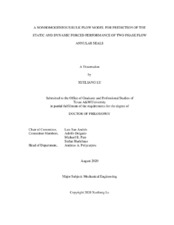| dc.description.abstract | In the subsea oil and gas industry, multiphase pumps and wet gas compressors are preferred technologies as they eliminate a conventional liquid-gas separation station to save up to 30% of capital investment. Seals in multiple phase pumps must be able to operate without compromising the system efficiency and its rotordynamic stability. However, both field operation and laboratory tests show that seals operating with liquid-gas mixtures could cause rotordynamic instability issues in a turbomachinery.
This dissertation advances a nonhomogeneous bulk flow model (NHBFM) for the prediction of the leakage and dynamic force coefficients of uniform clearance annular seals lubricated with gas in liquid mixtures. Compared to a homogeneous bulk flow model (HBFM) the NHBFM contains four diffusion coefficients in the inertia terms of the momentum equations, and a transport equation for the gas volume fraction (GVF).
To validate the model, predictions on leakage and dynamic force coefficients are compared against published results for three test seals supplied with a two-phase flow mixture. Two seals with a supply pressure Ps = 44.8 bara and a discharge pressure Pa = 6.9 bara emulate operating conditions in a subsea multiphase pump. The seals have the same diameter D = 89.3 mm and length L = 57.8 mm (L/D = 0.65), but different radial clearances, i.e., c = 0.140 ± 0.005 mm and 0.163 ± 0.005 mm, respectively. The shaft speed is 7,500 rpm (surface speed = 35 m/s), and the seal inlet GVF increases from 0 to 0.1. The mixture consists of compressed air and a synthetic oil with a low viscosity 4.53 cp at 40 ºC and density of 899 kg/m3. The flow Reynolds number is within the range of 870 to 1,100, representing a laminar flow.
The third test seal operates in a very different operating condition with a low pressure (Ps = 2.6 bara, Pa = 1 bara) and low shaft speed 3,500 rpm (surface speed = 23.3 m/s). The flow is an air in ISO VG10 mineral oil mixture with an inlet GVF spans 0 to 0.2. The maximum flow Reynolds number is less than 300. Thus, the flow is in laminar flow regime. The small pressure drop ΔP = 1.6 bar emulates operating conditions of impeller eye seals in electrical submersible pumps. The seal has a diameter D = 127 mm, length L = 46 mm (L/D = 0.36) and radial clearance c = 0.274 ± 0.005 mm.
For the first test seal operating with Ps = 44.8 bara and inlet GVF=0.1, the flow is mostly homogeneous as the maximum diffusion velocity at the seal exit plane is just ~0.1% of the liquid flow velocity. Thus, both the NHBFM and HBFM predict similar results for the pressure field, gas volume fraction field, leakage (mass flow rate) and shear drag torque. The difference between the predicted leakage and test data is less than 5%.
For operation with a Ps = 44.8 bara the NHBFM predicted direct stiffness (K) reduces faster with inlet GVF than that predicted by the HBFM. Although the NHBFM delivers 30% larger added mass (M) than the HBFM does, both models do predict a drop in M with the increase of inlet GVF. Both models predict similar direct damping coefficient (C) and cross-coupled stiffness (k) with a maximum difference of ~5% in both C and k for operation with inlet GVF= 0.1. Compared to the test data, the two models generally under predict C and k by the same amount of ~ 25%. Both C and k increase with inlet GVF for operation with inlet GVF < 0.1. Closely matching the test data, both models deliver a whirl frequency ratio (WFR) ~ 0.3 for the pure liquid seal. WFR increases to ~0.35 as the inlet GVF increases to 0.1.
For the third test seal operating with a low pressure (Ps = 2.6 bara) both the NHBFM and HBFM predict ~ 0 direct stiffness (K). For operation with inlet GVF=0.2, the NHBFM predicted M is 3.2 kg, about ~30 % below the test data 4 kg; the HBFM predicts a zero M. C and k predicted by both models are within uncertainty of the test data. For operation with a pure liquid or a mixture both models deliver accurate predictions in whirl frequency ratio (WFR ~ 0.5).
The comparisons of the predictions against test data from two-phase flow uniform clearance annular seals demonstrate that the NHBFM shows an improvement in prediction of the seals dynamic forced performance; in particular in direct stiffness (K), as compared to a HBFM. The difference in the predictions from the two models is primarily due to the distinct approaches to model the perturbed density of the two-phase flow, as is addressed later in the main context.
In contrast to commercial computational fluid dynamics (CFD) software packages that require hours or even several days to obtain the dynamics force coefficients, the current NHBFM only takes one or two minutes to complete a prediction. | en |


